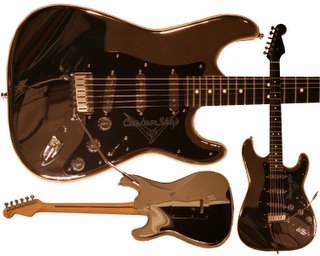GuitArt - The Guitar Calendar - "Excalibur"

Excalibur:
This is a 1993 chrome-finish Fender Custom Shop Stratocaster. It's the best Strat I've ever played, and I've played a few over the past few decades. In fact I own 4 Strats at the moment, and I've owned others in past years which I have since sold. But this one is very very special. One of a kind.
This is my main guitar today. I play this on almost every single song I record.
One day in May 2004, I was at the Guitar Show in Dallas, and looking closely at a strat copy made of 20,000 year old wood, when suddenly my friend Brent said from behind me, “Hey, look at that!” I turned and across the aisle was a strat-specialty place from Tokyo that sold only vintage strats. As a crowd-gathering attraction he had on a stand on a table, a special chrome strat with a big sign that said “Absolutely! Do NOT Touch!!!!”
We had never seen a strat with a chrome finish before. “Wow!" I said, "I wonder how they got a chrome finish to bond to wood like that! It must be super heavy!”
We noticed the large Fender Custom Shop logo on the pickguard. This one was something very very special. I couldn’t touch it but I was mesmerized like I hadn’t been since I saw Lightning in that store back in 1978. I finally pulled myself away from it to continue looking around the rest of the thousands of guitars at the guitar show, but at the end in the last few minutes before closing the show I came back to this shop to see the chrome custom shop strat again.
I talked to the owner, a Japanese man, and asked him if I could try playing it. He stopped, looked me up and down a few times, sizing me up to see if I could afford it, then he nodded. He turned and picked up the strat very carefully, and turned to me with the strat laying across both his hands like you would a precious sword.
In fact, it struck me that he handed it to me with the care and reverence as if it were Excalibur – the storied legendary sword of King Arthur. That is why I named the guitar that. As he handed it to me, he said, “This guitar from 1993. I go to Fender Custom Shop Factory. Buy this guitar. Only one like it. I don’t play it. I put in case, take home, put under bed. It staying there since then. 11 years. No one ever play it. I bring here to show to put on display. Attract customers. They buy other guitars. Never been played." And with that, he handed it to me.
I took it and was immediately amazed at how light it was. It is not wood at all, but actually it is a hollow aluminum body – that is how they could chrome it. It was perfectly balanced, and the neck played like a dream. I had never played a strat with a neck like that. An actual ebony fingerboard with rolled edges – it’s amazing for a Fender.
I couldn’t hear it through an amp, but I made him an offer anyway, just based on the way it played, the way it looked, and the uniqueness of it. We dickered back and forth a bit then agreed. I offered him my visa card. He shook his head in disgust and said, “No Visa. No check. Cash only.” I said “Cash!? But it’s thousands of dollars! No one carries that much cash around with them!” He shrugged and walked away, starting to tear down his booth since it was the end of the show. I put the guitar back on the stand and turned and walked away, disappointed. On the way out, Brent and I passed a cash machine. I eyed it as I walked by. Stopped. And thought. Nope – it has a limit of $500, I couldn’t get enough. So we left and went to dinner and talked about it.
Later that night, I sent a message out to the EJ list about the ‘One That Got Away’. And someone sent back a note with a link saying “Is this the guitar you played?” And there it was. It was the webste for that guy’s guitar store back in Tokyo, and he had taken a picture of the guitar in his store. Well I called him in Tokyo and asked if he remembered me and the deal we had agreed to. He said yes he did and would honor that price (even though it was far less than what he was asking for it.)
I wired him the money and he shipped me the guitar.
I remember the day, the moment, the UPS truck pulled up out front. I had been anxiously waiting for hours. It finally came, and I was almost dancing with excitement. I took it, opened it up and there it was finally in my arms again! This time I ran to my studio, plugged it in and played and it sounded beautiful. Normally guitars are made of wood of course, and the type of wood and it’s grain and density will determine aspects of it’s tone and level of sustain. Well this one is metal. Not wood at all, so it has a kind of slightly metallic sheen and shimmer and clarity to the sound that no other guitar I've played has. It is quite unique.
I found out later that in 1993, the Fender Custom Shop had ordered 150 custom aluminum bodies with chrome finish to be made up to their spec. They took 109 of them and engraved the Harley Davidson name into the body, and their logo onto the pickguard. These became the legendary Harley Davidson strats. Then they took 25 and engraved the name Mustang into the body, and put the car's logo on the pickguard. These became the famous and more rare Mustang Strats. Then they took 15 and engraved a setting of palm trees into the chrome body and these became the extremely rare, “Aloha” model strats. There was one left. They didn’t touch the body, they left it clean. Then they carved a large Fender Custom Shop logo itself into the pickguard. They only did that to one. This is that one. One of a kind, in that sense.
It was wonderful to play and hear, but in the spring of 2005, when I was starting to play with a band, I found that when I played it at band volumes through an amp, it squealed like a microphone. I had problems. So I decided to fix it. I took it apart, and made up a special mix of waxes, paraffin and beeswax, and melted them together and had them at 160 degrees F, and took out the pickups and dipped them in the wax to seal them. It’s called “potting the pickups” and it’s an old trick of guitar luthiers to seal the pickups and insulate against microphonic signals being picked up. Then I remembered Ted Nugent’s trick of stuffing pantyhose filled with foam into the f-holes of his hollow-body guitar to cut back on the feedback. I tried, but the gaps between the braces inside the body wouldn’t allow it, so instead, I got some spray foam insulation and a tiny straw nozzle, and strayed that into the body cavity through the cracks. That stuff expands as it dries, so I had to be very careful to put just the right amount.
So, after I put it all back together, and tried it – the nasty whistling feedback was greatly reduced and the guitar still sounds wonderful. It has a wonderful tone and resonance now. This has become my most heard guitar on all my recordings.


0 Comments:
Post a Comment
<< Home